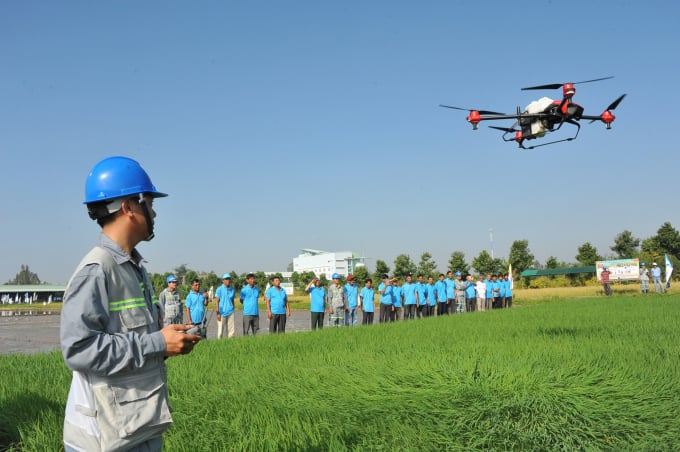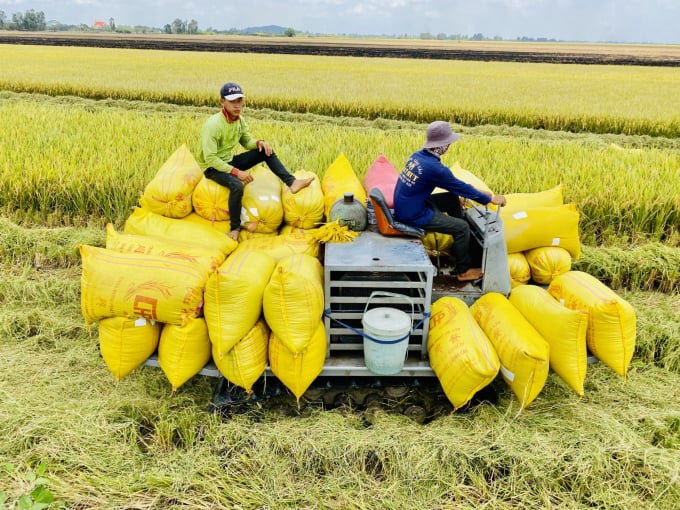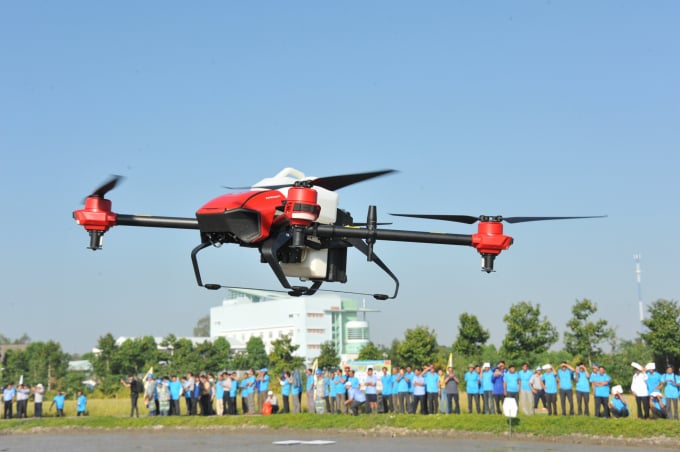May 24, 2025 | 16:25 GMT +7
May 24, 2025 | 16:25 GMT +7
Hotline: 0913.378.918
May 24, 2025 | 16:25 GMT +7
Hotline: 0913.378.918
Long Xuyen Quadrangle, the most famous granary of the Mekong Delta with an area of approximtely 400,000 ha, belongs to three provinces of Kien Giang, An Giang and Can Tho. It is said that that land was originally a dry grassland area, severely contaminated with salt and alum. But thanks to the efforts of people, digging canals to direct floods, washing out the salt and alum, also thanks to the "revolutions" in the fields, Long Xuyen Quadrangle has turned into a key agricultural area, providing 7-8 million tons of rice each year, contributing to ensuring national food security and exporting to the world.

Mechanization in the field in An Giang. Photo: Hoang Vu.
People’s enthusiasm, decisive policies and new construction works are what make the change in Long Xuyen Quadrangle, and the most obvious achievement is the new life for rice farmers. There are "landlords" who manage 200 ha per crop. And when it is time for the harvest, traders would willing to pay tens of billions of dong for the products.
And today, another "revolution" descends into this land.
An Giang province currently has 230,000 hectares of rice, mainly in the districts of Thoai Son, Tri Ton, Phu Tan and Chau Thanh. According to the "target" assigned, each year the land with the largest population in the West must ensure an output of 4 million tons of rice. With collective economic models being increasingly positive in both quantity and quality, people say: “not a big deal”.
Chairman of the Union of Thoai Son Cooperatives Nguyen Huu Tho led me through the vast fields of summer-autumn rice being harvested in Thoai Son. “There is more than 1,000 ha of rice here applying the model of ‘fields without footprint’ this year. Perhaps it is the most modern closed-chain rice farming model up to date,” said Mr. Tho.
Technology and mechanization have come to the fields. From tilling, pumping water, sowing seeds, spreading manure, spraying to harvesting, and transporting rice are all done by machines. Farmers do not have to put their hands on any stage of production.
It was in the midst of the peak rice harvest, but I could only see the scene of people standing and watching, doing nothing. There were laughter and the sound of people talking everywhere. “For a long time I thought that bringing the machine home was to create jobs to help people. In the end, ‘it’ even took all their work,” Mr. Tho said.
Thoai Son Cooperatives Union of Mr. Tho has just been established a little while ago on the basis of gathering seven agricultural cooperatives in Thoai Son district including An Binh, Binh Thanh, Tan Dong, Vong The, Son Hoa, Hoa Tan, Thang Loi and Son Hoa along with four affiliated cooperatives of Phu Thuan, Thanh Giang, Thanh My, and Oc Eo.
Starting from small and fragmented cooperatives, Thoai Son Cooperatives Union is now a rice growing community of more than 3,700 households with a farming area of approximately 23,000 ha. It is the result of the determination of An Giang and Loc Troi Group.
“It was only during the time Loc Troi associated with cooperatives and people in An Giang to develop the rice link chain that the weaknesses of the old-school cooperative were fully revealed. It was hard for agricultural cooperatives with only a few dozen members relying on a few meager services and discounted agricultural materials. The enterprises found no way to support cooperatives and expand their production area. Even when the enterprise wanted to bring machines and equipment to the field it did not seem to be an easy feat because the production scale was too small. We couldn’t just spend billions of dong to buy equipment just to let it run for one day and rest for three or four days straight.”

“For a long time I thought that bringing the machine home was to create jobs to help people. In the end, ‘it’ even took all their work.” Photo: Hoang Vu.
As of 2022 An Giang province has 192 agricultural cooperatives with more than 13,000 members, which means there are only 60-70 people in a cooperative on average. The task of cooperative unions like Thoai Son is to bring mechanization into the entire agricultural production procedure, turn the cooperatives into a place where people buy and sell materials together, increase services to serve members and become an intermediary partner between people and businesses.
The most urgent change required is the production organization stage and the human factor. A team of young, capable and knowledgeable staff of Loc Troi is "installed" in 30 cooperatives in the group's raw material areas in a “three-together” fashion: Eat together, live together, work together. They join the leadership of cooperatives to organize production and business. The cooperative’s chairman of the board of directors is still a local, but the director and deputy director are young people of Loc Troi. Harboring ambition and new perception, they carry the mission to change the way production is organized, mechanize fields, and open services for the members. All these "men" do not receive any salary from the cooperative.
Chairman of An Binh Agricultural Cooperative in Thoai Son district, Mr. Trinh Cong Minh is also an “unpaid man”. Mr. Minh, along with the director and deputy director of the cooperative, are "Loc Troi men" who run production on an area of 1,050 ha of rice. To them, the greatest achievement is the eradication of the scene where people have their selling prices pressured by traders or don’t have any place to sell rice when the harvest comes.
“When "Loc Troi men" came, the entire production organization was rearranged. Contracts for input supply, use of services of the cooperative, and rice underwriting were signed. After joining the cooperative, in addition to the policy of supplying input and collecting the money at the end of the crop without interest, farmers were also supported with VND 200/kg of rice produced according to the procedure.”

Collective economy has erased the fragmented mindset in An Giang. Photo: Hoang Vu.
Other agricultural cooperatives such as Vong The, Son Hoa, Hoa Tan, Thang Loi are the same. Benefits of collective economy are making cooperative union a widespread movement. People asking to join the cooperative, cooperative asking to join the cooperative union, cooperative union asking for "Loc Troi men", the applications are coming like a big wave. The raw material areas for rice production in Thoai Son, Tri Ton, Phu Tan and Chau Thanh have already become so vast, and people's mindset has also become a lot more open.
Actually I was able to hear about this peculiar information about farming from Mr. Truong Kien Tho, Deputy Director of An Giang Department of Agriculture and Rural Development. He also compared rice growers in An Giang to “kings”. They have all the options, they can produce however they like. Farming is both leisured and profitable as if their risks are already insured.
In the last summer-autumn crop, Thoai Son Cooperative Union has four methods of association for people to choose from.
For example, there is a form of associating while covering profit. People sign a contract with the cooperative at the beginning of the crop. The cooperative will take care of input and production services, so the people do not have to participate in any production stages. The two parties agree on the productivity and output, which the people commit to selling to the cooperative at a fixed price. The additional part will be sold at the market price.
Or the people can choose the traditional form of association. Loc Troi Group, through cooperatives, invests all inputs, uses the cooperative services, and purchases the rice according to the agreed price at the end of the crop.

Farming in the 4.0 period. Photo: Hoang Vu.
The "fields without footprints" is the latest association model, as the family of Mr. Nguyen Phi Son Ho in Tay Phu commune, Thoai Son district is doing. The family currently has 24 ha of fields. Associating with Loc Troi Group, as Mr. Ho says, means “being committed to a profit of VND 40 million/ha/year without having to do anything.” That’s the best part.
In this crop, Mr. Ho’s field is expecting an output of more than 200 tons of rice. Thanks to the “guaranteed profit” from this form of association, his family can collect billions of dong with ease.
“The beauty of "fields without footprints" lies in the synchronization of mechanization from the beginning to the end of the crop. All production stages are fully mechanized. This is also the basis for this form of association to be able to “guarantee profit" for farmers, because when mechanization is applied to the field, it saves the amount of seeds required, reduce the usage of fertilizers and pesticides. The production costs can be reduced by 20-30% compared to the traditional methods,” said the Deputy Director of An Giang Department of Agriculture and Rural Development.
Translated by Samuel Pham

(VAN) The People's Committee of Tra Vinh province has approved an adjustment to the investment policy for the Green Hydrogen Plant project, increasing its area to approximately 52.76 hectares.
![Reducing emissions from rice fields: [2] Farmers’ commitment to the soil](https://t.ex-cdn.com/nongnghiepmoitruong.vn/608w/files/news/2025/05/05/dsc08881jpg-nongnghiep-140632.jpg)
(VAN) Clean rice cultivation model in Thuong Tan commune, Bac Tan Uyen district, is assisting local residents in achieving sustainable agriculture by substantially reducing costs, increasing productivity, and protecting the environment.

(VAN) At the conference to disseminate Resolution No. 68, AgriS introduced its digital agricultural ecosystem and reaffirmed its commitment to accompanying the Government in promoting private sector development and sustainable agriculture.

(VAN) 'Blue Ocean - Blue Foods' initiative is designed to restore marine ecosystems and establish sustainable livelihoods for local communities by cultivating a minimum of 1,000 hectares of cottonii seaweed in the first three years.
/2025/05/21/4642-3-112707_603.jpg)
(VAN) The V-SCOPE project has made direct contributions to three out of six pillars of the Comprehensive Strategic Partnership between Vietnam and Australia.

(VAN) Facing the threat of rabies spreading to the community, Gia Lai province urgently carries out measures to vaccinate dogs and cats on a large scale.

(VAN) Disease-free livestock farming not only protects livestock herds but also stabilizes production and livelihoods for many farmers in Tuyen Quang.